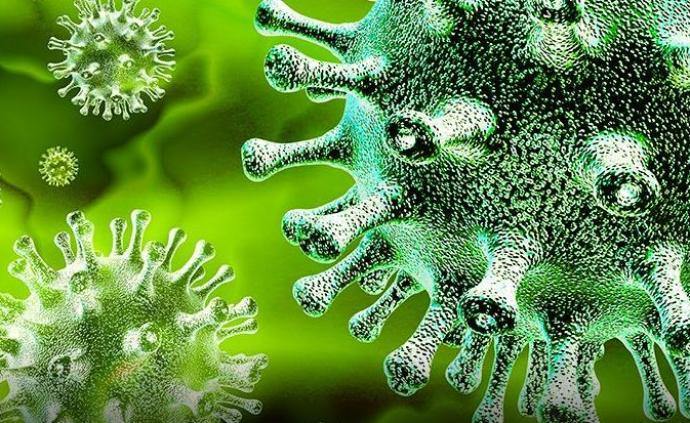
According to The Guardian on March 30, a detailed analysis of the structure of the COVID-19 virus shows that the stick-like "spikes" used to determine the infection are 4 times stronger when invading human cells than the SARS coronavirus.
This finding indicates that coronavirus particles inhaled through nose or mouth are likely to attach to upper respiratory tract cells, which means that it takes relatively less time to infect people.
Scientists at the University of Minnesota used X-ray crystallography to draw an atomic 3D map of the virus's spike protein and its corresponding partner on human cells, known as the ACE-2 receptor.
The report said that when the virus encounters human cells, the spike protein on its surface will entangle the ACE-2 receptor. If the cells have such a receptor, the virus can enter the cells and replicate them.
Dr. Li Fang, who led the US team, said: "The 3D structure shows that compared with the virus that caused the SARS outbreak in 2002, the COVID-19 virus has developed a new strategy to allow it to be attached to human receptors more closely, which allows the virus to infect human cells and spread from person to person. "
Scientists will use the virus's map to find potential drugs to inactivate the virus before it accelerates replication and infect people.
The researchers wrote in the journal Nature describing how they compared the structure of the COVID-19 virus with related strains in bats and pangolins. They found that both animal strains can bind to the human ACE-2 receptor, thus supporting the previous research finding that human coronavirus either directly comes from bats or from pangolin infected by bats. Before infecting humans, these animal strains obtained key mutations, thus making the virus easier to spread from human to human.
Jonathan Bauer, a professor of virology at Nottingham University who was not involved in the study, said: "The SARS-CoV-2 virus, which caused the COVID-19 epidemic, behaves differently from its relative SARS. In particular, SARS-CoV-2 can cause throat and nose infection and the infected patients will show mild symptoms like colds, while the SARS virus almost always replicates itself in the lungs.
He said: "This study provides an attractive reason for this difference: the spike protein on the surface of the SARS-CoV-2 virus can more effectively bind to the cell surface protein called ACE-2, which is the gateway for these viruses to enter cells. This enhanced binding may allow the virus to infect the nose and throat more effectively, while the ACE-2 level in the nose and throat is considered below. "
He added: "The study result is still just a theory and the specific impact needs to be confirmed by further tests."
据英国《卫报》3月30日报道,对这种病毒结构的详细分析显示,它用来确定感染状况的、像棍棒一样的“刺突”在侵入人体细胞时的强度是严重急性呼吸综合征(SARS)冠状病毒的4倍。
这一发现表明,通过鼻子或嘴巴吸入的冠状病毒粒子很有可能附着在上呼吸道细胞上,这意味着要让感染站稳脚跟所需的时间相对较少。
明尼苏达大学的科学家利用X射线结晶学绘制了一张该病毒的刺突蛋白及其在人体细胞上的相应伙伴——已知为ACE-2受体——的原子级3D图谱。
报道称,当病毒遇到人体细胞时,其表面的刺突蛋白会缠住ACE-2受体,如果细胞拥有这样的受体的话,就使病毒得以进入细胞并进行复制。
领导这个美国团队的李方(音)博士说:“3D结构表明,与导致2002年SARS疫情暴发的病毒相比,这种新型冠状病毒进化出新的战略,将其与人类受体结合,且结合更加紧密。与人类受体的紧密结合有助于病毒感染人体细胞并在人与人之间传播。”
科学家们现在将利用该病毒的图谱来寻找潜在的药物,以便在病毒复制加速、感染站稳脚跟之前使其失效。
研究人员在《自然》杂志上撰文描述了他们是如何将这种流行冠状病毒的结构与蝙蝠和穿山甲中的相关菌株进行比较的。他们发现,这两种动物菌株都可以与人类的ACE-2受体结合,从而支持了此前有关人类冠状病毒要么直接来自蝙蝠、要么来自本身被蝙蝠感染的穿山甲的研究工作。在感染人类之前,这些动物菌株获得了关键的突变,从而使病毒更容易在人类中传播。
没有参与这项研究的诺丁汉大学病毒学教授乔纳森·鲍尔说:“引发新冠肺炎的SARS-CoV-2病毒的表现与其亲戚SARS截然不同。尤其是,SARS-CoV-2可有效感染喉咙和鼻子,导致像感冒的轻微症状,而SARS几乎总是在肺部复制病毒。
他说:“这项研究为这种差异提供了一个吸引人的理由:SARS-CoV-2病毒表面的刺突蛋白能够更有效地与被称为ACE-2的细胞表面蛋白结合,而ACE-2是这些病毒进入细胞的门户。这种增强的结合可能会使病毒更有效地感染鼻子和喉咙,而在鼻子和喉咙里ACE-2的水平被认为较低。”
他还说:“这项研究还只是一个理论。具体的影响需要通过进一步的试验来证实。”
(Executive Editor: Ye Ke)